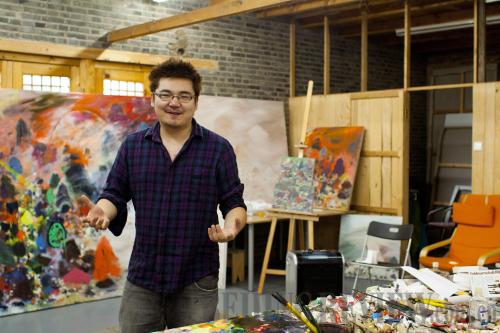|
 |
|
ABSTRACT ALLURE: artist Jiajia Wang (PHOTO BY MAYA REID) |
Jiajia Wang's studio is located in the middle of an orchard on the outskirts of Beijing. The 25-year-old painter spends most of his days alone creating large abstract geometric landscapes that pop with color. His work, a twist on traditional Chinese landscape painting, has been exhibited in both Europe and China. The paintings sell for about 80,000 yuan ($11,940) a piece.
Decked out in plastic-frame glasses and a flannel shirt, Wang exudes warmth talking about his life in Beijing. Raised by two painters and educated at the esteemed Central Saint Martins College of Art and Design in London, his work is full of cross-cultural references exploring ideas of identity both Eastern and Western.
Wang enjoys being an artist in China. "Just seeing how [the country] has evolved has changed my thinking," he says. He has worked steadily since moving back to Beijing after graduation. Asked how many paintings he has sold, he answers genially: "I don't know, quite a few. I'm not sure how many exactly."
From boom to bust
Wang's relaxed attitude is a contrast to the extreme changes that have staggered China's contemporary art scene in recent years.
In 2007, five of the world's 10 top-selling living artists were Chinese, according to auction monitor Artprice.com. Ranked highest among these was Zhang Xiaogang. Zhang, a painter in his 50s famous for depicting subjects with large, dark eyes in monochromatic portraits, earned $56 million that year, more than doubling his 2006 income of $24.9 million. Skyrocketing figures were typical of the contemporary art boom in China, which lasted from 2005 to 2008.
When the global economic crisis hit in late 2008, the art market bottomed out. That fall, auction house Sotheby's was barely able to sell 40 of its 110 Chinese contemporary pieces at auction. Prices were too high. ArtTactic, a UK-based art market analysis firm measuring the perceived level of speculation in China's contemporary art market, found it to be 73 percent higher than for the Western market.
Galleries in places like Beijing's renowned 798 art district began to shut down. "[Before,] everybody had been floating the surface," says Vivienne Li, the communications director for the Ullens Center for Contemporary Art (UCCA) located in 798. "The crisis slowed everything down [but] calmed everybody down. [Artists] had more time to think."
|